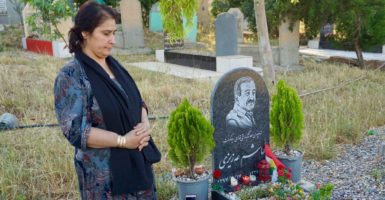KOYA, Iraq—Just outside this town in Iraqi Kurdistan, a cemetery sits on a raised plot of land facing east toward the border with Iran, about 40 miles away. Buried here are the fallen leaders and peshmerga fighters of the Kurdish Democratic Party of Iran, an exiled and armed opposition group.
On this day in late May, in the hour before sunset during the Islamic holy month of Ramadan, about two dozen Kurds solemnly gathered before the polished headstones.
It’s a daily ritual, a Kurdish peshmerga soldier explained to this correspondent.
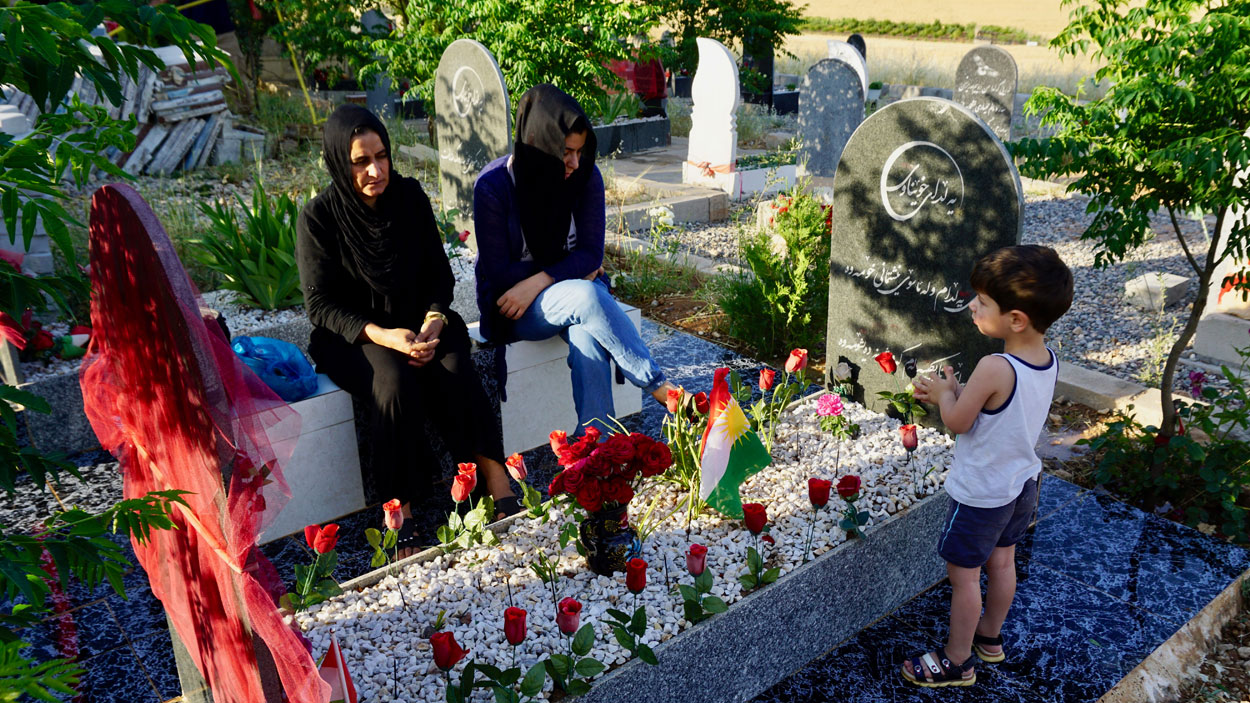
On Sept. 8, 2018, Iranian missiles killed 16 Kurds at the Kurdistan Democratic Party of Iran’s headquarters in the Iraqi town of Koya. (Photos: Nolan Peterson/The Daily Signal)
Some of the mourners were widows. Some were simply there to honor the dead.
As the setting sun in the west illuminated the low mountains to the east in soft, end-of-day light, Sourya Pairwan stood beside the grave of her husband, Hasham Azizi, a leader of the Kurdish Democratic Party of Iran, or KDPI, who died during an Iranian missile strike in September.
“He died fighting for the freedom of the Kurdish people in Iran,” Pairwan said.
The widow looked down at her folded hands and softly added: “We still have hope for our freedom. We still have hope that the U.S. and Europe will help us achieve it.”
On the morning of Sept. 8, 2018, Iran’s Islamic Revolutionary Guard Corps launched a barrage of seven ballistic missiles into Iraqi Kurdistan, targeting KDPI’s headquarters here in Koya.
Iran’s missiles that day killed 16 Kurds; 48 more were wounded, including civilians and children. Sections of KDPI’s fortified compound were reduced to ruins.
Iran later verified its role in the missile strikes through a press release.
“It is very difficult for our people here. We are not safe—Iran will try to kill you anywhere,” KDPI member Mouloud Swara, 59, told The Daily Signal during an interview at the group’s Koya headquarters.
On May 27, the KDPI compound in Koya remained scarred from the attack eight months earlier. The missiles’ craters were filled in, but the circular plots of deposited earth, about 20 yards across, spoke to the devastating power of the warheads.

Shrapnel damage from an Iranian missile strike at the Kurdistan Democratic Party of Iran’s headquarters in the Iraqi town of Koya.
Buildings damaged in the attack mostly were repaired, although some remained pockmarked by shrapnel—random patchworks of destruction that resembled thrown paint on a Jackson Pollock canvas. The Kurds painted murals over the damaged walls, blending shrapnel divots into the designs.
Security was tight at the gate. Inside the compound’s fortified walls, peshmerga fighters milled about in traditional Kurdish sal u sepik uniforms, invariably with a Kalashnikov assault rifle slung over a shoulder, or a pistol tucked into a waistband.
The demeanor of the fighters was friendly. Yet world events had them energized, ready for action. A single question was on everyone’s mind: Will the U.S. go to war with Iran?
“Our people will be happy if the U.S. attacks Iran, but Iran will absolutely retaliate against us,” Asso Hassan Zadeh, KDPI’s deputy secretary general, said in an interview with The Daily Signal.
“This is a moment of maximum opportunity and danger for us,” Zadeh said. “Tehran sees us as America’s allies, and they may try to send a message to the U.S. by striking us.”
Mixed Blessing
In late May, amid the backdrop of increasing military tension between the U.S. and Iran, The Daily Signal visited the headquarters of four Kurdish Iranian opposition groups operating in exile from enclaves within Iraqi Kurdistan.
These groups, in addition to KDPI, included the Komala Party of Iranian Kurdistan, the Komala Kurdistan’s Organization of the Communist Party of Iran, and the Organization of Iranian Kurdistan Struggle.
As the U.S. and Iran edge toward a military conflict, these armed groups are lying in wait, ready to throw their political and military weight behind a potential U.S. effort to overthrow Iran’s ruling mullahs. This is a required step, many Kurds believe, toward their overall goal of achieving an autonomous Iranian Kurdistan.
“This could be a moment of change. The prospect of a U.S. attack on Iran has given us hope,” said Kako Alyar, 34, a peshmerga fighter and head of the Central Committee Secretariat of the Komala Party of Iranian Kurdistan.
“We’re always ready to go to war,” Alyar said.
The peshmerga are a volunteer Kurdish fighting force that represents an ancient warrior tradition that predates Alexander the Great. In Kurdish, the word peshmerga roughly translates to “one who faces death.”
Following the 1979 Iranian revolution, Ayatollah Ruhollah Khomeini, then head of the newly installed Shia theocracy, declared war against the Kurdish people, who are mainly Sunni, because of their demands for democracy and an autonomous Iranian Kurdistan.
Iran’s Kurds fought back from neighboring northern Iraq, forming a collection of armed opposition groups. For decades, these groups have sent their peshmerga fighters over the mountainous border into Iran to wage an on-again, off-again guerrilla war against Tehran’s forces.
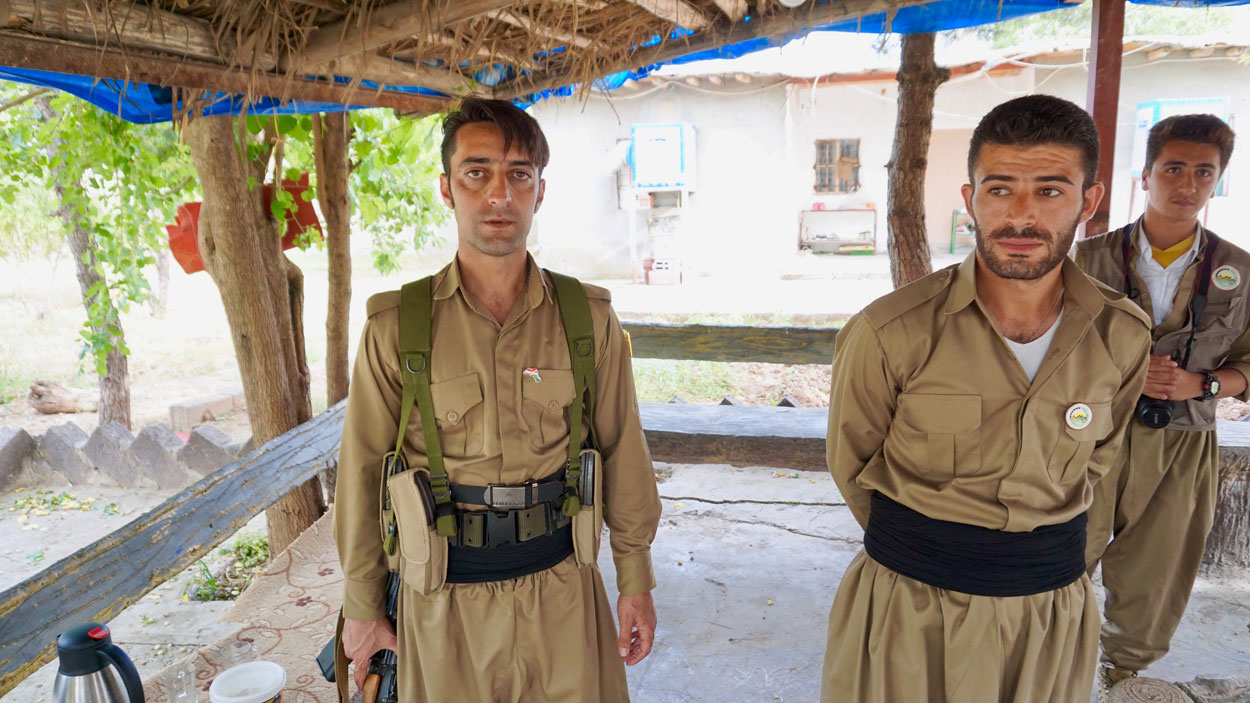
The peshmerga are a volunteer Kurdish fighting force, which represents an ancient warrior tradition dating back from before Alexander the Great.
These opposition groups are well aware of the fact that they don’t wield the requisite firepower to overthrow the Iranian government by force. For that reason, the Kurds generally see a potential conflict between the U.S. and Iran as a fortuitous opportunity to achieve their goals at last.
For one, the Kurds’ military forces were tied up for years supporting the U.S.-led war effort against the Islamic State, also known as ISIS. With the caliphate’s demise, the opposition groups are able to rededicate their full forces to subversive activities in Iran at a moment when Tehran is under increasing pressure from the dual effects of U.S. sanctions and the specter of war.
‘No Hope of Reform’
At the very least, some believe that a war might weaken Tehran’s grip on power, giving the Kurds’ clandestine networks of armed sleeper cells and civil-society activists—already in place in Iran—more leverage to carve out an autonomous Iranian Kurdistan.
“We prefer political means,” the KDPI’s Zadeh said. “But this is the Iranian regime. The only language they speak is violence. I have no hope of reform with this regime—overthrowing the government is a necessity for us to achieve our goals. When your people are attacked, you have to defend yourself.”
Estimates vary, but about 7 million Kurds currently live in Iran, predominantly within a swath of northwestern territory called Rojhelat, which comprises about 10% of the country’s overall landmass.
Kurds from this region describe a police state in which Iran’s Islamist regime has enforced draconian measures to stifle the long-simmering Kurdish rights movement. A United Nations report last September condemned Tehran’s systematic violation of its citizens’ human rights, singling out mistreatment of the Kurds.
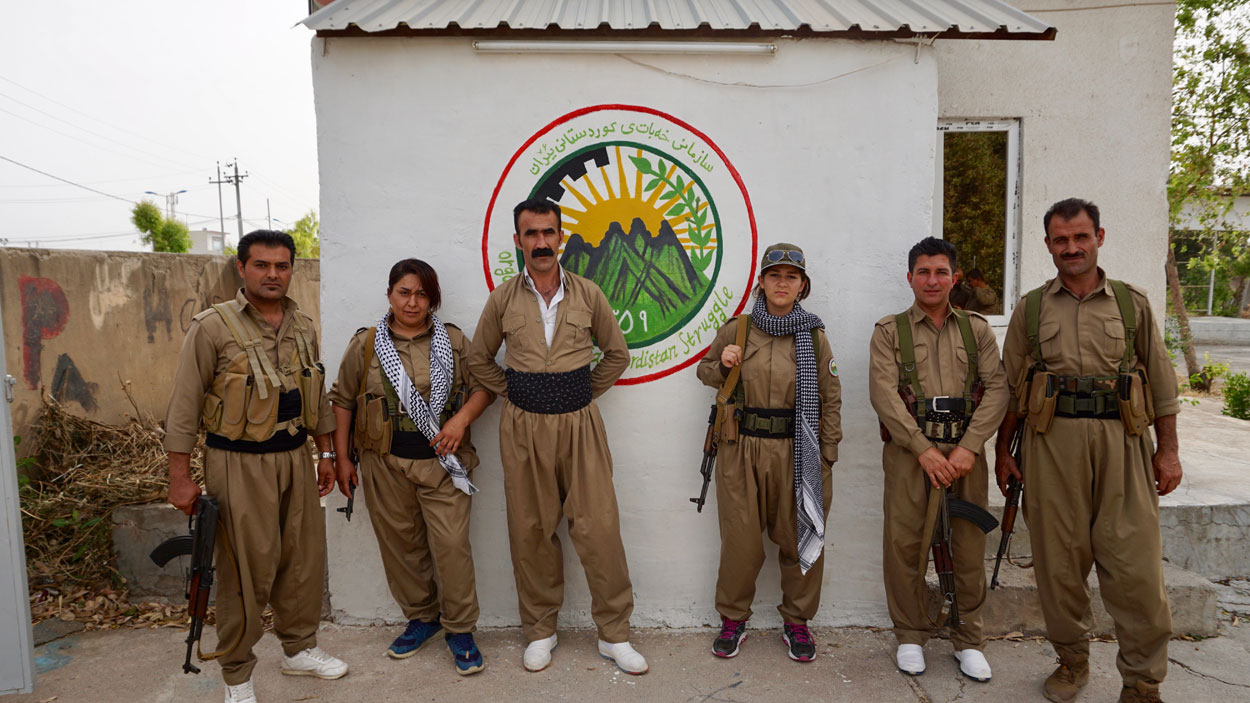
The Organization of Iranian Kurdistan comprises female peshmerga fighters.
“All Kurdish Iranian parties are fighting for our national rights—whether by achieving autonomy or federalization within Iran,” Zadeh said. “We are a nation whose territory has been divided. Our dream is an independent Kurdistan.”
Even if Kurdish Iranian opposition parties share a common purpose, they’ve been hobbled by infighting for decades.
Consequently, about a year and a half ago, five parties created the Cooperation Centre of Iranian Kurdistan’s Political Parties. The body’s goal is to unify political and military actions against the Iranian government. So far, however, the alliance has proven to be a shaky one.
“Unfortunately, our ties are very weak today. We don’t have enough cohesion between the parties. But when the time comes, we will unite,” said Ebrahim Alizada, first secretary of the Komala Kurdistan’s Organization of the Communist Party of Iran.
Dream of a Homeland
The Kurds proved stalwart American allies against the regime of Iraqi dictator Saddam Hussein. That alliance paved the way for creation of an autonomous Iraqi Kurdistan in northern Iraq—a self-governing enclave with its own government, budget, military forces, and immigration laws.
“We’re looking for the same opportunity for Kurdish autonomy in Iran that we have in Iraq,” Alizada said. “A collapse of the Iranian regime would be an opportunity for an independent Iranian Kurdistan.”
The Kurds see Tehran as on edge, anticipating a U.S. gambit to enlist the help of Kurdish opposition groups to provoke a revolution. Consequently, many say they believe that a U.S. military strike on Iran likely would spur Tehran to retaliate against the opposition groups based in Iraqi Kurdistan.
The opposition groups already face the constant threat of attack from Iran’s Islamic Revolutionary Guard Corps, as well as from Tehran’s proxy militias, which operate with relative impunity in Iraq.
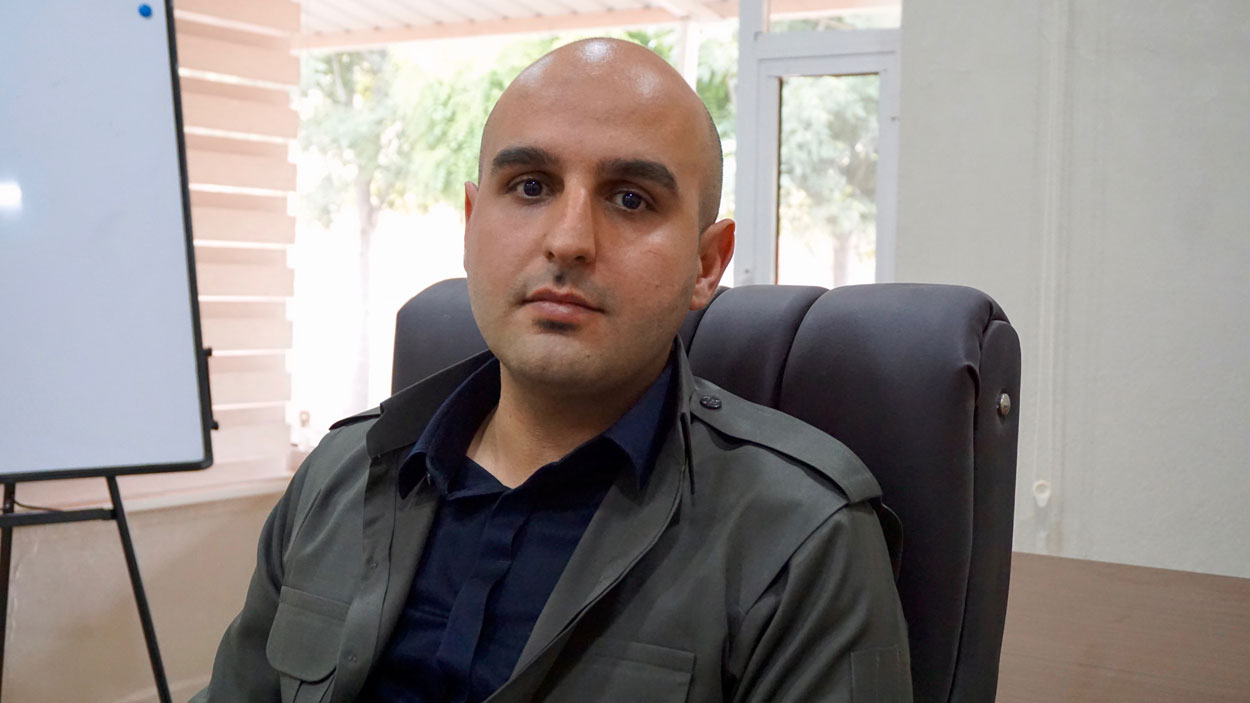
Kako Alyar, 34, head of the Central Committee Secretariat of the Komala Party of Iranian Kurdistan, an opposition group based near the Iraqi city of Sulaymaniyah.
With the Iranian threat in mind, all four of the Kurdish Iranian compounds visited by The Daily Signal were fortified, and all personnel were armed—even during downtime.
Yet despite the constant danger and the certainty of Tehran’s retribution, the Kurds appear resolutely ready for war should the U.S. strike Iran.
“If we think the regime is vulnerable, we’re ready to send our troops tomorrow,” said Babeshex Husaini, secretary general of the Organization of Iranian Kurdistan Struggle, an opposition group based in the town of Topzawa.
“The Iranian people are ready for a revolution,” Husaini, 54, said.
The Communists
Originally based in the Zagros Mountains on the border with Iran, the Komala Kurdistan’s Organization of the Communist Party of Iran shifted to its redoubt outside Sulaymaniyah in 1989 after striking a deal with Saddam some 14 years before the Iraqi dictator was deposed.
Founded as a far-left militant group that espoused Marxist-Leninist ideology, the opposition party—known simply as Komala among Kurds—has adopted a more moderate, mainstream political stance as well as a less militaristic program.
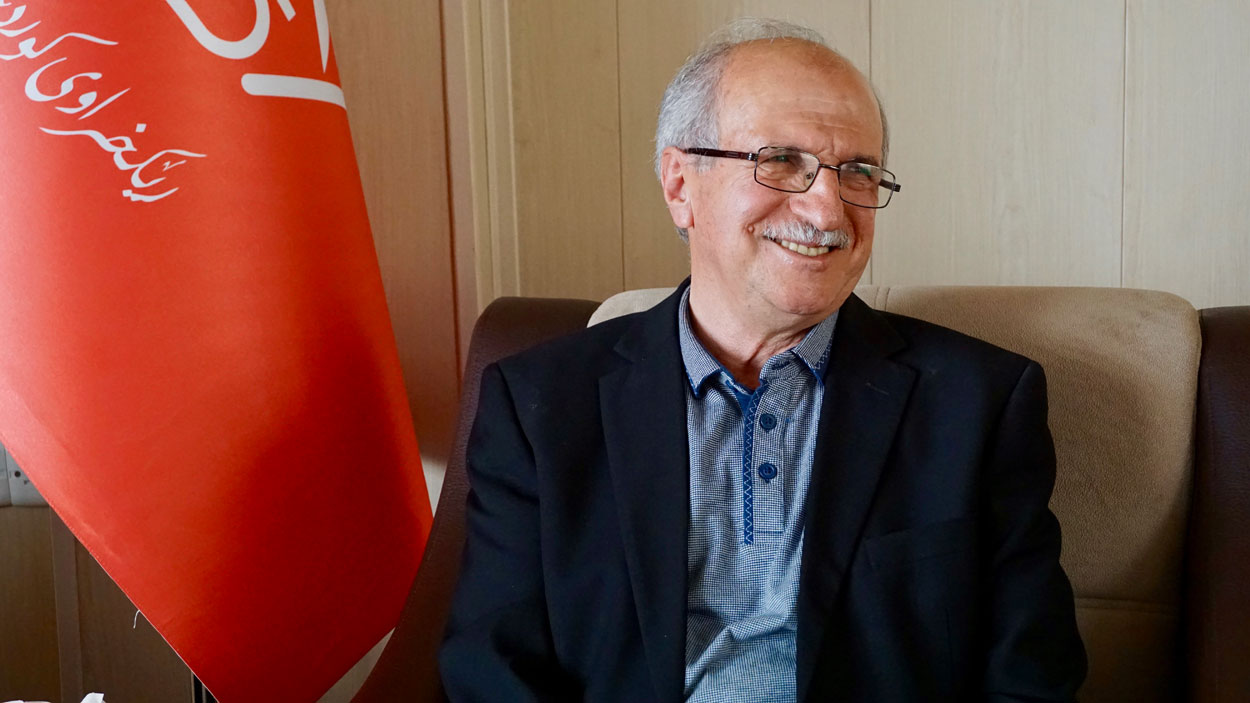
Ebrahim Alizada, first secretary of the Komala Kurdistan’s Organization of the Communist Party of Iran, an opposition party based near the Iraqi city of Sulaymaniyah.
“Our main aim is to make a socialist society in Iran,” said Ebrahim Alizada, Komala’s first secretary. “To achieve this end, we have to destroy the regime.”
About 1,000 exiled Iranian Kurds, including peshmerga fighters and their families, live at the Komala camp, which has become a refuge of sorts for Kurds who fled Iran. Here, the party maintains de facto autonomy within Iraqi Kurdistan—it’s off-limits to the Kurdistan Regional Government police, according to Kurds living there.
A barbed-wire fence surrounds the facility. Several military outposts perched on the summits of the surrounding peaks maintain constant watch over the 1-kilometer-square central camp.
Iranian forces operating inside Iraq frequently launch mortars and rockets at the enclave from nearby villages. Iranian operatives have slipped across the perimeter to plant improvised explosive devices, or IEDs, within the compound, peshmerga living there told The Daily Signal. When leaving the compound, the Iranian Kurds strictly travel in convoys for protection.
“We are constantly under pressure from Iran,” Alizada said. “Our peshmerga have been murdered. And we face the danger or Iranian rockets, snipers, and mortars.”
Sharukh Mohammadi, a peshmerga with the group, said he left Iran in 2011 after a two-year prison term for dissident activities. He served briefly in the Iranian military, he said, but was passed over for promotion because he was a Kurd.
Later, after escaping Iran, he served alongside U.S. military advisers in combat against the Islamic State.
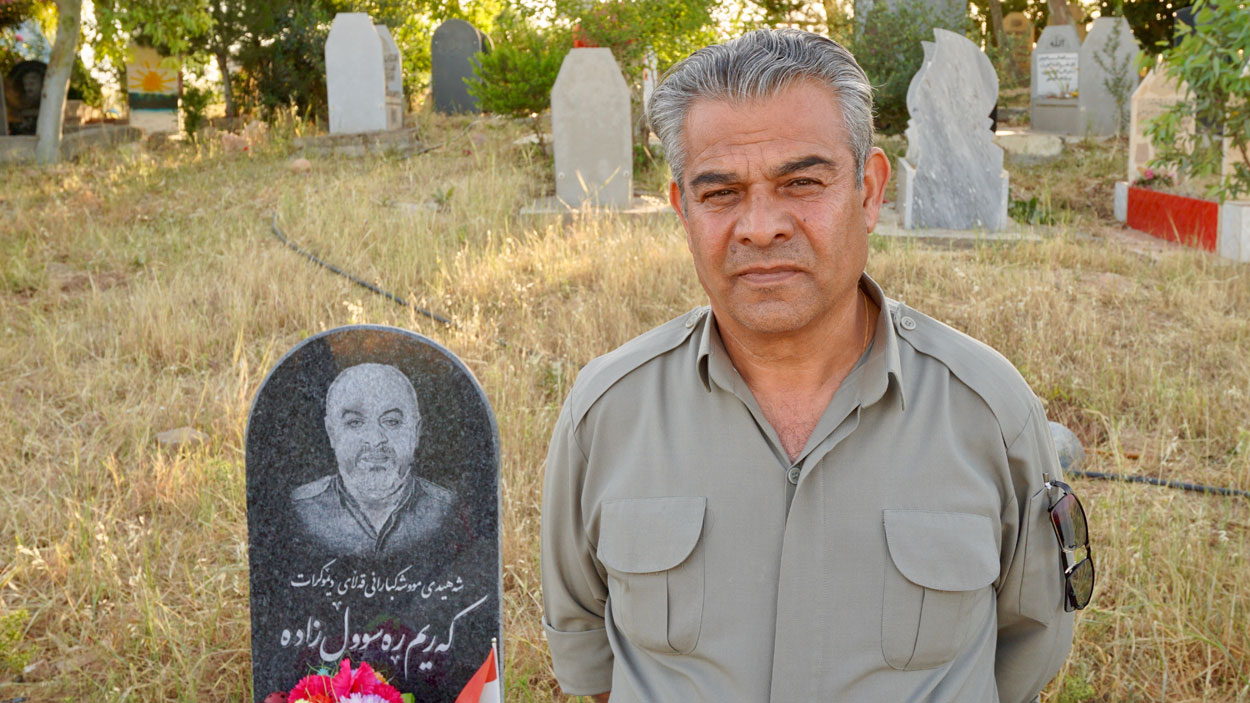
“We are not safe—Iran will try to kill you anywhere,” said Mouloud Swara, 59, a member of the Kurdistan Democratic Party of Iran.
“There is no freedom for humanity in Iran, the government is a dictatorship,” Mohammadi, 41, said, describing why he left his homeland to live in exile. “I left home to achieve freedom and democracy for my people.”
The Komala party furnishes its peshmerga fighters with three meals a day, uniforms, and about $100 a month in spending money.
Exiled Iranian Kurds such as Mohammadi are not officially citizens of Iraqi Kurdistan. However, they’re allowed to live freely in the territory due to what Alizada called a “gentleman’s agreement” with the Kurdistan Regional Government, the governing body of Iraqi Kurdistan.
Unlike some of the other Kurdish Iranian opposition groups operating from within Iraqi Kurdistan, the Communist Party of Iran is much more focused on supporting covert political groups and using information as a weapon. Military force is viewed as a last resort.
“We are a political party, and our struggle is political,” said Alizada, who struck a cautious note about the repercussions of a U.S. military strike on Iran.
“All our military forces are here in Iraq, and they’re ready. But now is not the time to send our troops to Iran,” Alizada said.
‘Worse than Saddam’
A separate communist opposition group—the Komala Party of Iranian Kurdistan—is based at another mountain enclave near Sulaymaniyah.
With polished English and a diplomat’s skill for purposeful discourse, Alyar, a party head, explained why his group ditched its communist ideology in 2000.
“We couldn’t believe in an idea that didn’t work,” Alyar said. “Communism didn’t work in the USSR or Europe, so it won’t work in Iranian Kurdistan either. We believe in democracy for Iran, and autonomy for Iranian Kurdistan.”

Mourners at the graves of Kurds killed by an Iranian missile strike.
Founded more than 50 years ago and with about 1,000 peshmerga fighters currently based in Iraq, the Komala Party of Iranian Kurdistan maintains sleeper cells throughout Iran, Alyar said. The cells comprise “tens of thousands of covert operatives” ready for immediate action to help topple the government in Tehran, said Alyar, head of the group’s Central Committee.
“With this regime, we believe it’s almost impossible to have any changes,” Alyar said. “The regime in Iran is a bad one—it’s an ideological, totalitarian dictatorship. It’s worse than Saddam. They’ve shown they’re not willing to negotiate.”
The Komala Party of Iranian Kurdistan abandoned direct military confrontation with Tehran’s forces in 1995. Yet mortar and rocket attacks from Iran still frequently target the group’s headquarters near Sulaymaniyah.
“Our enemy is the Iranian regime, and when pressure on the regime increases, the pressure on us increases as well,” Alyar said. “On a daily basis, Iran’s missiles and mortars are focused on us and they’re ready to attack us imminently. The Iranian regime thinks that the U.S. will repeat its plan with the Kurds, like it used the Kurds against Saddam.”
The Komala Party of Iranian Kurdistan sent about 200 peshmerga fighters to fight against the Islamic State, acquiring valuable combat experience as well as crucial training from U.S. forces in the process—while they purposefully steered clear of areas in Iraq where Iranian militias operated, Alyar said.
Perhaps most importantly, Alyar added, his organization’s peshmerga fighters are riding a morale boost following victory in combat as they pivot back to a full focus on Iran and consider the ramifications of potential U.S. military action.
“On a daily basis, our peshmerga ask me if there will be a change, if the U.S. will finally do something and attack the [Iranian] regime,” Alyar said. “They’re hoping for a change. And hope gives them the will to fight. Our troops are prepared. We trained them; now they are ready.”
Alyar added that the U.S. has not reached out to his organization to organize any joint military activities.
‘We Are Not Terrorists’
KDPI fought against the government of Shah Muhammad Reza Pahlavi during Iran’s 1979 revolution. After a subsequent crackdown by the country’s post-revolutionary theocracy, the group went into exile in northern Iraq.
KDPI waged a guerilla war against the Iranian government for years, ultimately abandoning its mountain headquarters on the border with Iran in 1993 due to constant Iranian airstrikes and shelling. The new headquarters in the town of Koya, however, swiftly fell under Tehran’s crosshairs.
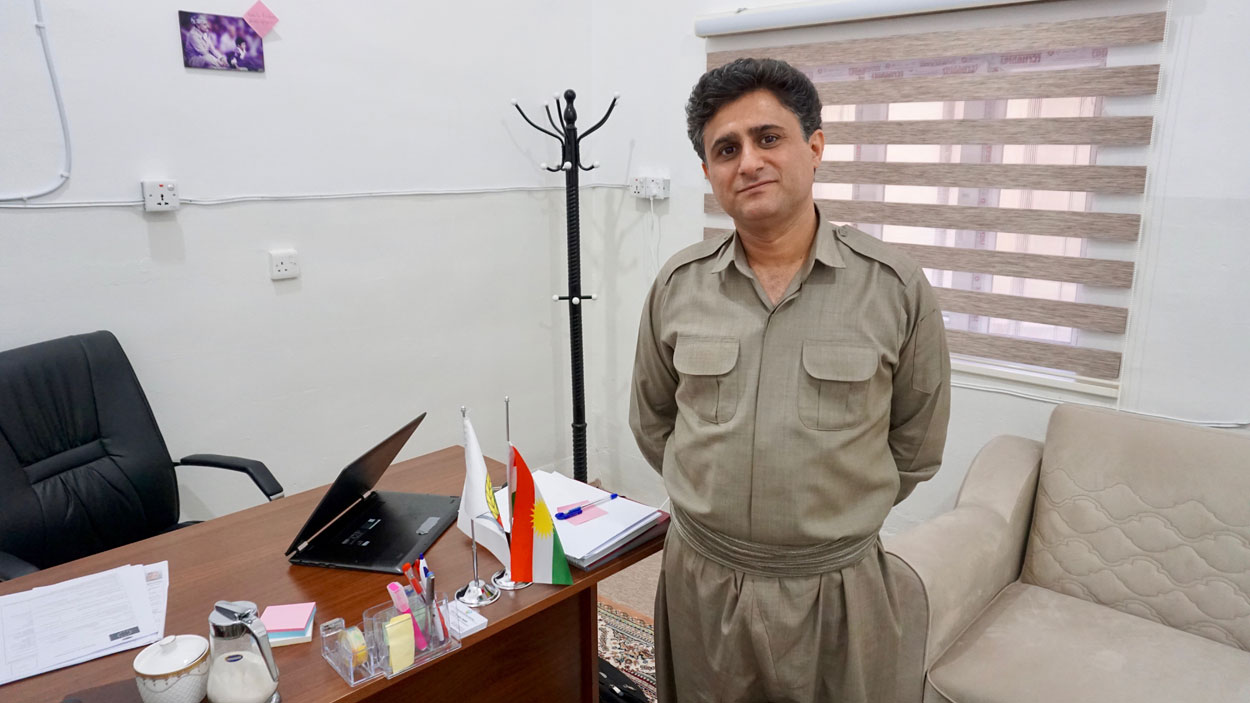
Asso Hassan Zadeh, deputy secretary general of the Kurdistan Democratic Party of Iran.
Iranian warplanes bombed the location in 1994. Then, Iranian forces staged a cross-border ground assault in 1996; KDPI’s peshmerga fighters repulsed the attack with the help of U.S. warplanes enforcing a no-fly zone over northern Iraq at that time, Zadeh said.
About 300 of KDPI’s peshmerga soldiers died in combat from 1991 to 1997, Zadeh said, adding that their guerrilla campaign against Iranian forces ended in the mid-1990s.
Despite the detente, KDPI remains banned in Iran, where it is designated as a terrorist organization. Nevertheless, the group eschewed a military retaliation to the September 2018 missile attack, opting instead to organize a general strike within the Iranian Kurdistan region.
“The regime prefers us to attack; they want to show the world that we are terrorists,” Zadeh said. “But our focus remains on strengthening the civil society movement within Iranian Kurdistan. We did not send our members to kill those who attacked us—although we could have easily done so. No, we chose to continue the struggle in other ways.”
Still, KDPI continues to send small military units—comprising about 15 or 20 peshmerga fighters apiece—across the Zagros Mountains into Iran to maintain contact with an underground network of sleeper cells and operatives poised to support a countrywide uprising. These units sometimes engage in skirmishes with Iranian forces in the mountainous Iraq-Iran border region.
“We don’t deny that our peshmerga are inside Iran, but we are not conducting terrorist attacks,” Zadeh said. “We reject terrorism. We are not terrorists.”
After KDPI curtailed its guerilla war in the mid-1990s, Iran’s military strikes tapered off. Yet Iranian forces bombed KDPI’s Koya headquarters in 2016, killing six Kurds in what was to be the opening salvo of a new era of hostilities.
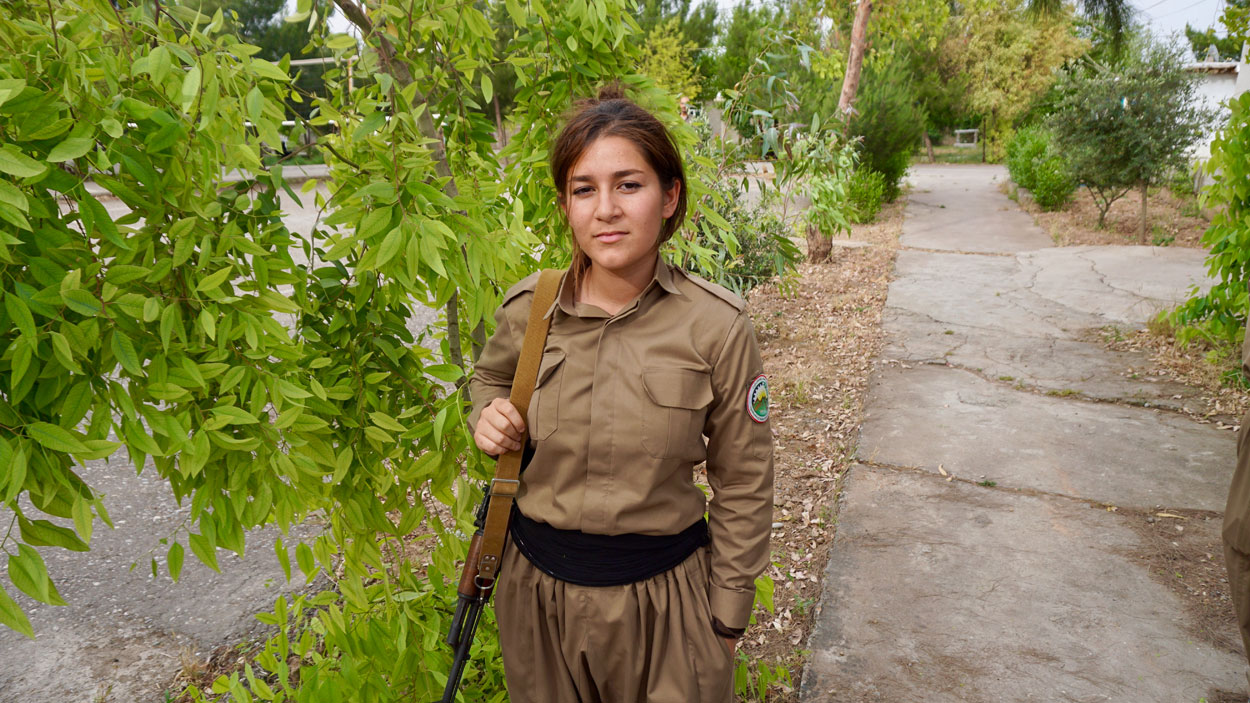
In Zadeh’s estimation, Tehran is under pressure from a weak economy, spurring the theocratic government to lash out abroad at perceived threats to its power.
“The Iranian regime is constantly plotting against us,” Zadeh said. “Our party is the most prepared of all the Iranian opposition groups, and the regime fears our leverage on the population.”
KDPI leadership won’t disclose the number of peshmerga fighters it has based in Iraqi Kurdistan, or the size of its forces inside Iran. However, Zadeh said the group could gather “100,000 or 200,000 Kurds inside Iran if there’s a revolution.”
Ready for War
Known as Sazmani Xebati Kurdistani Irani among Kurds, the Organization of Iranian Kurdistan Struggle is a secular group that includes Sunni and Shia Muslims as well as Christians.
The group’s headquarters in the town of Topzawa is a modest, fortified compound, easily overlooked from the road. Inside the grounds, however, one finds clusters of armed peshmerga soldiers clad in traditional Kurdish uniforms. All the fighters are exiled Iranians, many of whom risked their lives to leave Iran for Iraq.
Among the Kurdish troops was 19-year-old Shaista Mohammed, who recently graduated secondary school and wants to be a doctor.
Mohammed said she escaped Iran eight months ago, pretending to be a tourist to get across the border into Iraq. Her parents are proud of her, she explained, although she’s worried about their safety now that she has taken up arms against the government.
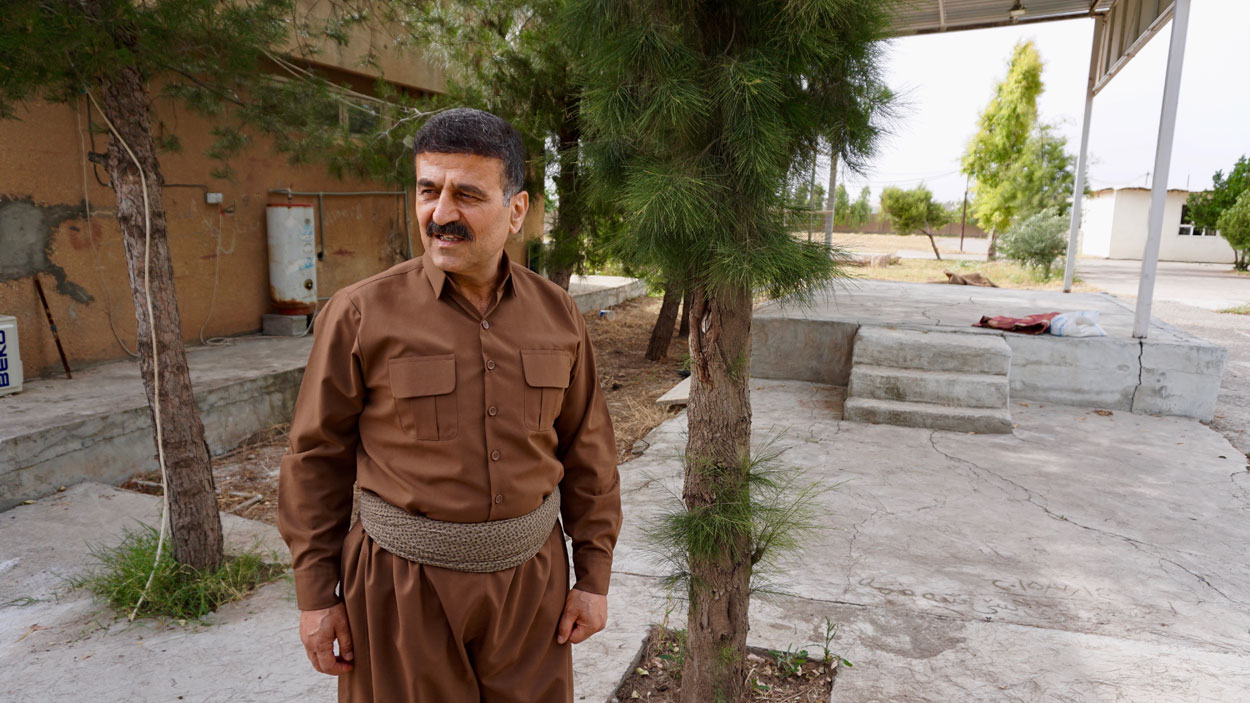
Babeshex Husaini, 54, secretary general of the Organization of Iranian Kurdistan Struggle, an opposition group based in the town of Topzawa, just outside of Erbil, the capital of Iraqi Kurdistan.
When asked about a possible war between the U.S. and Iran, Mohammed replied: “I feel lucky. I believe that a U.S. attack on Iran will help our cause. I’m ready to fight.”
The anticipation of one’s baptism by fire is an unnerving prospect for all soldiers—regardless of age, sex, or nationality. Mohammed said her steadfast belief in “the morality of the freedom struggle” tempered her fear of going to war.
“I couldn’t stand to see what Iran was doing to its people,” she said, explaining her decision to become a peshmerga.
Standing nearby, a peshmerga named Saghar, 18, said she fled Iran four months ago because “things are very difficult in Iran and I wanted to fight for my freedom.”
Saghar wore the traditional sal u sepik uniform, too, and had a Kalashnikov slung over her shoulder. She stood confidently, shoulders squared, her chin up and shoulders back.
When asked about the possibility of U.S. military action against Iran, she replied: “I’m 100% ready to fight tomorrow if America attacks.”
‘Many Brave Fighters’
Atta Badburin, 37, another peshmerga fighter with the group, said he left Iran four years ago because “our lives were in danger every day.”
“The secret service hunted us,” Badburin said. “It was very dangerous.”
Regarding the possibility of a U.S. military strike on Iran, Badburin said: “We are very lucky with this situation. We hope the U.S. attacks and we can go back to Iran to fight for our independence.”
“We have many brave fighters,” said Husaini, secretary general of the Organization of Iranian Kurdistan Struggle. He especially praised the courage of his group’s peshmerga soldiers who fought against ISIS, saying they “played a big role” in defending Iraqi Kurdistan.
“Our military actions against Daesh were meant to defend all the Kurdish people,” Husaini said, using using a pejorative Arabic acronym for the Islamist terrorist army.
Husaini did not disclose how many fighters his group fields in Iraq, and emphasized that his troops were not involved in active combat against Iran. However, he said the Organization of Iranian Kurdistan Struggle maintains a network of sleeper cells within Iran that can activate on a moment’s notice to support an armed, countrywide uprising.
“Our sleeper cells in Iran are ready for any new circumstances,” Husaini said, adding that their funding comes from a network of patrons in Europe and Iraqi Kurdistan.
“We have maintained our military training and we’re willing to send troops into Iran tomorrow—we’ve made some very specific preparations for any sudden events that might happen in Iran,” Husaini said.

The armed, exiled Kurdish Iranian opposition groups generally welcomed military tensions between the U.S. and Iran, viewing a potential war as an opportunity to finally overthrow the mullahs.
During an extensive interview with The Daily Signal at his party’s headquarters, Husaini showed off a lifetime’s patchwork of scars accumulated during what he described as roughly 60 Iranian assassination attempts.
A bullet wound was visible on his right cheek. Long scars ran down his arms and legs, evidence of bombings. The old soldier pointed out his wounds to this correspondent with the satisfaction of a man directing attention to a wall full of framed diplomas and awards.
“Iran has asked us to negotiate, but we’ve always rejected it,” Husaini said. “I know better than anyone about Iran’s regime; I’ve been fighting them for 40 years.”
He paused for an instant, then added: “I wish there was an alternative to violence, but there is none.”
Although he welcomed the notion of a joint military effort with U.S. forces, Husaini said the U.S. government has not contacted his organization to coordinate actions against Iran.
“We are friends with the U.S.,” Husaini said. “But we’re not yet allies.”

























